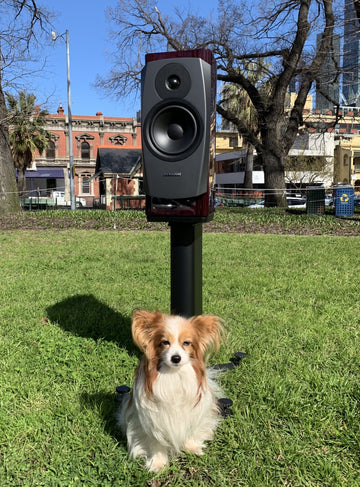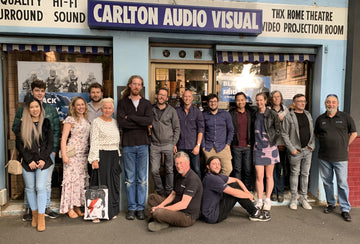 Generically bookshelf speakers are those medium sized transducers between 20 and 40 cm high that are designed generally to be mounted with their tweeters at ear level.
There is an optimum size of loudspeaker where the various parameters of efficiency, frequency response, bass performance, cabinet neutrality, peak sound pressure level meet.
There are other more subjective less easily quantifiable facets of loudspeaker performance often referred to in critical reviews as characteristics such as “brightness” “imageing quality” “richness” “speed” “depth” “detail” “air” ... that are all linked to the raw design parameters of the speaker.
Speakers using cone and dome moving coil technology cannot be below a certain size without one of the basic performance characteristics being compromised. Typically that would be the sensitivity and the bass response.
There have been examples of extremely small loudspeakers unsupplemented by subwoofers that still perform very well up to a point. Proac Tablettes or Celestion SL6 come to mind. These were expensive designs that gave a good semblance of bass however they brutally compromised the efficiency and reactive load characteristics... meaning that they needed massive power amplifiers to drive and even then they were not capable of a very high Sound Pressure Level.
Unsurprisingly it is the Brits that first made mass market small form factor speakers a workable reality. Wharfedale with the Diamond and Mordaunt Short with the MS10 produced ultra compact 20 x 25 x 25cm boxes that made a semblance of real bass and were driveable by the new crop of high current output stage amplifiers of the eighties.
I sold the Mordaunt Short MS10 in particular and it was a lot of fun ... however the reality was it was quite inefficient and ran out of bass depth rapidly with higher SPL. The somewhat unscrupulous retail chain I worked for at the time made great mileage of the Mordaunt Shorts rated power of 300 watts courtesy of their Positec electrochemical clipping protection.
Do I need to say that power is the least relevant specification of a loudspeaker? Probably...
The way you will damage your loudspeaker is not with too much power. It is nearly always a clipped waveform from an overdriven amplifier that will cause damage to the voice coil of a speaker drive unit. In other words you are more likely to damage your speakers with a small amplifier being driven hard than with a large amplifier being driven gently.
The greatest gains in volume ... aka peak undistorted sound pressure level ... do not come about by using a very high powered amplifier, but rather through selecting speakers that are appropriately efficient for your intended use. A 3db difference in spl is subjectively double the volume, to achieve a 3db gain through wattage one needs ten times the power. It is a logarithmic relationship between power and volume.
There is a reason why we have so many speakers of the bookshelf category at Carlton Audio Visual, in fact I know visiting us for the first time can be a bemusing experience for the uninitiated the first time. I recall retailers with different purveyance philosophies visiting us and expostulating loudly at our range of loudspeakers ( I note sadly that we are still here and they are long dissolved)
Number one reason is that we love them.
These bookshelf speakers are so diverse and represent some of the best of design, style, and sonic accomplishments for the money being asked.
Number two is that the relevant technologies of drive units, materials, and cabinet design meet in a box that’s about thirty to thirty five centimetres high and twenty five wide and thirty deep with a two way drive unit configuration ...
This is not quite fashionable, fashion in speakers, aka “Lifestyle product” would usually entail either something spectacularly slim a la Bang and Olufsen or something small and plastic supplemented by a subwoofer a la Bose.
Neither of those physical extremes is functionally the best for making a good loudspeaker that actually performs well for all types of music.
In fact these designs where form has overridden function often have to be electronically equalised and processed to make them even partially sonically acceptable.
So the result of this for Carlton Audio Visual is that we sell bookshelf speakers from $300 through to $30,000 with a huge brand diversity.
So here’s a few of our current fanatics choice of bookshelf speakers:
Q Acoustic 3010i .. $449
almost a Mordaunt short MS10 but with thirty years of development.
The Monitor Audio Bronze 2 … $590
An outstandingly versatile all-rounder. For many people this is all the loudspeaker you will ever need … which for us as a purveyor is disappointing as we would really like you to buy something more expensive from us…
These have been our budget mainstay since 2015 and the new version is coming soon , it had better be good.
Dynaudio Emit 10 $999
The entry point Dynaudio loudspeaker that manages to encapsulate all the Dyne virtues of tonal neutrality and cohesive presentation. It is unnaturally cheap for a Dynaudio as the distributor desperately keeps it to the magic $999 price point.
Legend Joey $1199
A beautifully voiced and ridiculously solid speaker made by the Australian Maestro designer Dr Rod Crawford.
Krix Acoustix $1395
D’Appolito configuration two way that is an Australian made and designed product that is good at almost everything. Particularly good at genuine bookshelf positioning surrounded by a library …
Acoustic Energy AE500 $2499
Uses its small footprint to generate a huge holographic while conveying a sense of scale that is remarquable.
PMC Twenty5.22 $3995
Made by hand in Luton but much better than a Vauxhall ever was. This transmission line parallelogram is an end run for many audiophile seekers of musical truth.
Klipsch Heresy $5599
A throwback from 1947 but still a thing … and ok it’s not quite a bookshelf speaker but it’s not quite a floorstanding speaker either. What it is though is a fully horn loaded three way with 99db sensitivity. These rock like a fresh baby boomer back from the Eighth Airforce setting up home in middle America …
Dynaudio Confidence 20 $17,995
This is perfect … possibly the most technically accurate moving coil loudspeaker you can procure.
Sonus faber Guarneri Tradition $21,999
A loudspeaker physically so beautiful that it would be enough to have them disconnected as a work of static art. When you play music through them from an Audio Research system its enough to make one think of leaving your job and family just to own a pair …
Generically bookshelf speakers are those medium sized transducers between 20 and 40 cm high that are designed generally to be mounted with their tweeters at ear level.
There is an optimum size of loudspeaker where the various parameters of efficiency, frequency response, bass performance, cabinet neutrality, peak sound pressure level meet.
There are other more subjective less easily quantifiable facets of loudspeaker performance often referred to in critical reviews as characteristics such as “brightness” “imageing quality” “richness” “speed” “depth” “detail” “air” ... that are all linked to the raw design parameters of the speaker.
Speakers using cone and dome moving coil technology cannot be below a certain size without one of the basic performance characteristics being compromised. Typically that would be the sensitivity and the bass response.
There have been examples of extremely small loudspeakers unsupplemented by subwoofers that still perform very well up to a point. Proac Tablettes or Celestion SL6 come to mind. These were expensive designs that gave a good semblance of bass however they brutally compromised the efficiency and reactive load characteristics... meaning that they needed massive power amplifiers to drive and even then they were not capable of a very high Sound Pressure Level.
Unsurprisingly it is the Brits that first made mass market small form factor speakers a workable reality. Wharfedale with the Diamond and Mordaunt Short with the MS10 produced ultra compact 20 x 25 x 25cm boxes that made a semblance of real bass and were driveable by the new crop of high current output stage amplifiers of the eighties.
I sold the Mordaunt Short MS10 in particular and it was a lot of fun ... however the reality was it was quite inefficient and ran out of bass depth rapidly with higher SPL. The somewhat unscrupulous retail chain I worked for at the time made great mileage of the Mordaunt Shorts rated power of 300 watts courtesy of their Positec electrochemical clipping protection.
Do I need to say that power is the least relevant specification of a loudspeaker? Probably...
The way you will damage your loudspeaker is not with too much power. It is nearly always a clipped waveform from an overdriven amplifier that will cause damage to the voice coil of a speaker drive unit. In other words you are more likely to damage your speakers with a small amplifier being driven hard than with a large amplifier being driven gently.
The greatest gains in volume ... aka peak undistorted sound pressure level ... do not come about by using a very high powered amplifier, but rather through selecting speakers that are appropriately efficient for your intended use. A 3db difference in spl is subjectively double the volume, to achieve a 3db gain through wattage one needs ten times the power. It is a logarithmic relationship between power and volume.
There is a reason why we have so many speakers of the bookshelf category at Carlton Audio Visual, in fact I know visiting us for the first time can be a bemusing experience for the uninitiated the first time. I recall retailers with different purveyance philosophies visiting us and expostulating loudly at our range of loudspeakers ( I note sadly that we are still here and they are long dissolved)
Number one reason is that we love them.
These bookshelf speakers are so diverse and represent some of the best of design, style, and sonic accomplishments for the money being asked.
Number two is that the relevant technologies of drive units, materials, and cabinet design meet in a box that’s about thirty to thirty five centimetres high and twenty five wide and thirty deep with a two way drive unit configuration ...
This is not quite fashionable, fashion in speakers, aka “Lifestyle product” would usually entail either something spectacularly slim a la Bang and Olufsen or something small and plastic supplemented by a subwoofer a la Bose.
Neither of those physical extremes is functionally the best for making a good loudspeaker that actually performs well for all types of music.
In fact these designs where form has overridden function often have to be electronically equalised and processed to make them even partially sonically acceptable.
So the result of this for Carlton Audio Visual is that we sell bookshelf speakers from $300 through to $30,000 with a huge brand diversity.
So here’s a few of our current fanatics choice of bookshelf speakers:
Q Acoustic 3010i .. $449
almost a Mordaunt short MS10 but with thirty years of development.
The Monitor Audio Bronze 2 … $590
An outstandingly versatile all-rounder. For many people this is all the loudspeaker you will ever need … which for us as a purveyor is disappointing as we would really like you to buy something more expensive from us…
These have been our budget mainstay since 2015 and the new version is coming soon , it had better be good.
Dynaudio Emit 10 $999
The entry point Dynaudio loudspeaker that manages to encapsulate all the Dyne virtues of tonal neutrality and cohesive presentation. It is unnaturally cheap for a Dynaudio as the distributor desperately keeps it to the magic $999 price point.
Legend Joey $1199
A beautifully voiced and ridiculously solid speaker made by the Australian Maestro designer Dr Rod Crawford.
Krix Acoustix $1395
D’Appolito configuration two way that is an Australian made and designed product that is good at almost everything. Particularly good at genuine bookshelf positioning surrounded by a library …
Acoustic Energy AE500 $2499
Uses its small footprint to generate a huge holographic while conveying a sense of scale that is remarquable.
PMC Twenty5.22 $3995
Made by hand in Luton but much better than a Vauxhall ever was. This transmission line parallelogram is an end run for many audiophile seekers of musical truth.
Klipsch Heresy $5599
A throwback from 1947 but still a thing … and ok it’s not quite a bookshelf speaker but it’s not quite a floorstanding speaker either. What it is though is a fully horn loaded three way with 99db sensitivity. These rock like a fresh baby boomer back from the Eighth Airforce setting up home in middle America …
Dynaudio Confidence 20 $17,995
This is perfect … possibly the most technically accurate moving coil loudspeaker you can procure.
Sonus faber Guarneri Tradition $21,999
A loudspeaker physically so beautiful that it would be enough to have them disconnected as a work of static art. When you play music through them from an Audio Research system its enough to make one think of leaving your job and family just to own a pair …
Opinions
Bookshelf loudspeakers

 Generically bookshelf speakers are those medium sized transducers between 20 and 40 cm high that are designed generally to be mounted with their tweeters at ear level.
There is an optimum size of loudspeaker where the various parameters of efficiency, frequency response, bass performance, cabinet neutrality, peak sound pressure level meet.
There are other more subjective less easily quantifiable facets of loudspeaker performance often referred to in critical reviews as characteristics such as “brightness” “imageing quality” “richness” “speed” “depth” “detail” “air” ... that are all linked to the raw design parameters of the speaker.
Speakers using cone and dome moving coil technology cannot be below a certain size without one of the basic performance characteristics being compromised. Typically that would be the sensitivity and the bass response.
There have been examples of extremely small loudspeakers unsupplemented by subwoofers that still perform very well up to a point. Proac Tablettes or Celestion SL6 come to mind. These were expensive designs that gave a good semblance of bass however they brutally compromised the efficiency and reactive load characteristics... meaning that they needed massive power amplifiers to drive and even then they were not capable of a very high Sound Pressure Level.
Unsurprisingly it is the Brits that first made mass market small form factor speakers a workable reality. Wharfedale with the Diamond and Mordaunt Short with the MS10 produced ultra compact 20 x 25 x 25cm boxes that made a semblance of real bass and were driveable by the new crop of high current output stage amplifiers of the eighties.
I sold the Mordaunt Short MS10 in particular and it was a lot of fun ... however the reality was it was quite inefficient and ran out of bass depth rapidly with higher SPL. The somewhat unscrupulous retail chain I worked for at the time made great mileage of the Mordaunt Shorts rated power of 300 watts courtesy of their Positec electrochemical clipping protection.
Do I need to say that power is the least relevant specification of a loudspeaker? Probably...
The way you will damage your loudspeaker is not with too much power. It is nearly always a clipped waveform from an overdriven amplifier that will cause damage to the voice coil of a speaker drive unit. In other words you are more likely to damage your speakers with a small amplifier being driven hard than with a large amplifier being driven gently.
The greatest gains in volume ... aka peak undistorted sound pressure level ... do not come about by using a very high powered amplifier, but rather through selecting speakers that are appropriately efficient for your intended use. A 3db difference in spl is subjectively double the volume, to achieve a 3db gain through wattage one needs ten times the power. It is a logarithmic relationship between power and volume.
There is a reason why we have so many speakers of the bookshelf category at Carlton Audio Visual, in fact I know visiting us for the first time can be a bemusing experience for the uninitiated the first time. I recall retailers with different purveyance philosophies visiting us and expostulating loudly at our range of loudspeakers ( I note sadly that we are still here and they are long dissolved)
Number one reason is that we love them.
These bookshelf speakers are so diverse and represent some of the best of design, style, and sonic accomplishments for the money being asked.
Number two is that the relevant technologies of drive units, materials, and cabinet design meet in a box that’s about thirty to thirty five centimetres high and twenty five wide and thirty deep with a two way drive unit configuration ...
This is not quite fashionable, fashion in speakers, aka “Lifestyle product” would usually entail either something spectacularly slim a la Bang and Olufsen or something small and plastic supplemented by a subwoofer a la Bose.
Neither of those physical extremes is functionally the best for making a good loudspeaker that actually performs well for all types of music.
In fact these designs where form has overridden function often have to be electronically equalised and processed to make them even partially sonically acceptable.
So the result of this for Carlton Audio Visual is that we sell bookshelf speakers from $300 through to $30,000 with a huge brand diversity.
So here’s a few of our current fanatics choice of bookshelf speakers:
Q Acoustic 3010i .. $449
almost a Mordaunt short MS10 but with thirty years of development.
The Monitor Audio Bronze 2 … $590
An outstandingly versatile all-rounder. For many people this is all the loudspeaker you will ever need … which for us as a purveyor is disappointing as we would really like you to buy something more expensive from us…
These have been our budget mainstay since 2015 and the new version is coming soon , it had better be good.
Dynaudio Emit 10 $999
The entry point Dynaudio loudspeaker that manages to encapsulate all the Dyne virtues of tonal neutrality and cohesive presentation. It is unnaturally cheap for a Dynaudio as the distributor desperately keeps it to the magic $999 price point.
Legend Joey $1199
A beautifully voiced and ridiculously solid speaker made by the Australian Maestro designer Dr Rod Crawford.
Krix Acoustix $1395
D’Appolito configuration two way that is an Australian made and designed product that is good at almost everything. Particularly good at genuine bookshelf positioning surrounded by a library …
Acoustic Energy AE500 $2499
Uses its small footprint to generate a huge holographic while conveying a sense of scale that is remarquable.
PMC Twenty5.22 $3995
Made by hand in Luton but much better than a Vauxhall ever was. This transmission line parallelogram is an end run for many audiophile seekers of musical truth.
Klipsch Heresy $5599
A throwback from 1947 but still a thing … and ok it’s not quite a bookshelf speaker but it’s not quite a floorstanding speaker either. What it is though is a fully horn loaded three way with 99db sensitivity. These rock like a fresh baby boomer back from the Eighth Airforce setting up home in middle America …
Dynaudio Confidence 20 $17,995
This is perfect … possibly the most technically accurate moving coil loudspeaker you can procure.
Sonus faber Guarneri Tradition $21,999
A loudspeaker physically so beautiful that it would be enough to have them disconnected as a work of static art. When you play music through them from an Audio Research system its enough to make one think of leaving your job and family just to own a pair …
Generically bookshelf speakers are those medium sized transducers between 20 and 40 cm high that are designed generally to be mounted with their tweeters at ear level.
There is an optimum size of loudspeaker where the various parameters of efficiency, frequency response, bass performance, cabinet neutrality, peak sound pressure level meet.
There are other more subjective less easily quantifiable facets of loudspeaker performance often referred to in critical reviews as characteristics such as “brightness” “imageing quality” “richness” “speed” “depth” “detail” “air” ... that are all linked to the raw design parameters of the speaker.
Speakers using cone and dome moving coil technology cannot be below a certain size without one of the basic performance characteristics being compromised. Typically that would be the sensitivity and the bass response.
There have been examples of extremely small loudspeakers unsupplemented by subwoofers that still perform very well up to a point. Proac Tablettes or Celestion SL6 come to mind. These were expensive designs that gave a good semblance of bass however they brutally compromised the efficiency and reactive load characteristics... meaning that they needed massive power amplifiers to drive and even then they were not capable of a very high Sound Pressure Level.
Unsurprisingly it is the Brits that first made mass market small form factor speakers a workable reality. Wharfedale with the Diamond and Mordaunt Short with the MS10 produced ultra compact 20 x 25 x 25cm boxes that made a semblance of real bass and were driveable by the new crop of high current output stage amplifiers of the eighties.
I sold the Mordaunt Short MS10 in particular and it was a lot of fun ... however the reality was it was quite inefficient and ran out of bass depth rapidly with higher SPL. The somewhat unscrupulous retail chain I worked for at the time made great mileage of the Mordaunt Shorts rated power of 300 watts courtesy of their Positec electrochemical clipping protection.
Do I need to say that power is the least relevant specification of a loudspeaker? Probably...
The way you will damage your loudspeaker is not with too much power. It is nearly always a clipped waveform from an overdriven amplifier that will cause damage to the voice coil of a speaker drive unit. In other words you are more likely to damage your speakers with a small amplifier being driven hard than with a large amplifier being driven gently.
The greatest gains in volume ... aka peak undistorted sound pressure level ... do not come about by using a very high powered amplifier, but rather through selecting speakers that are appropriately efficient for your intended use. A 3db difference in spl is subjectively double the volume, to achieve a 3db gain through wattage one needs ten times the power. It is a logarithmic relationship between power and volume.
There is a reason why we have so many speakers of the bookshelf category at Carlton Audio Visual, in fact I know visiting us for the first time can be a bemusing experience for the uninitiated the first time. I recall retailers with different purveyance philosophies visiting us and expostulating loudly at our range of loudspeakers ( I note sadly that we are still here and they are long dissolved)
Number one reason is that we love them.
These bookshelf speakers are so diverse and represent some of the best of design, style, and sonic accomplishments for the money being asked.
Number two is that the relevant technologies of drive units, materials, and cabinet design meet in a box that’s about thirty to thirty five centimetres high and twenty five wide and thirty deep with a two way drive unit configuration ...
This is not quite fashionable, fashion in speakers, aka “Lifestyle product” would usually entail either something spectacularly slim a la Bang and Olufsen or something small and plastic supplemented by a subwoofer a la Bose.
Neither of those physical extremes is functionally the best for making a good loudspeaker that actually performs well for all types of music.
In fact these designs where form has overridden function often have to be electronically equalised and processed to make them even partially sonically acceptable.
So the result of this for Carlton Audio Visual is that we sell bookshelf speakers from $300 through to $30,000 with a huge brand diversity.
So here’s a few of our current fanatics choice of bookshelf speakers:
Q Acoustic 3010i .. $449
almost a Mordaunt short MS10 but with thirty years of development.
The Monitor Audio Bronze 2 … $590
An outstandingly versatile all-rounder. For many people this is all the loudspeaker you will ever need … which for us as a purveyor is disappointing as we would really like you to buy something more expensive from us…
These have been our budget mainstay since 2015 and the new version is coming soon , it had better be good.
Dynaudio Emit 10 $999
The entry point Dynaudio loudspeaker that manages to encapsulate all the Dyne virtues of tonal neutrality and cohesive presentation. It is unnaturally cheap for a Dynaudio as the distributor desperately keeps it to the magic $999 price point.
Legend Joey $1199
A beautifully voiced and ridiculously solid speaker made by the Australian Maestro designer Dr Rod Crawford.
Krix Acoustix $1395
D’Appolito configuration two way that is an Australian made and designed product that is good at almost everything. Particularly good at genuine bookshelf positioning surrounded by a library …
Acoustic Energy AE500 $2499
Uses its small footprint to generate a huge holographic while conveying a sense of scale that is remarquable.
PMC Twenty5.22 $3995
Made by hand in Luton but much better than a Vauxhall ever was. This transmission line parallelogram is an end run for many audiophile seekers of musical truth.
Klipsch Heresy $5599
A throwback from 1947 but still a thing … and ok it’s not quite a bookshelf speaker but it’s not quite a floorstanding speaker either. What it is though is a fully horn loaded three way with 99db sensitivity. These rock like a fresh baby boomer back from the Eighth Airforce setting up home in middle America …
Dynaudio Confidence 20 $17,995
This is perfect … possibly the most technically accurate moving coil loudspeaker you can procure.
Sonus faber Guarneri Tradition $21,999
A loudspeaker physically so beautiful that it would be enough to have them disconnected as a work of static art. When you play music through them from an Audio Research system its enough to make one think of leaving your job and family just to own a pair …





